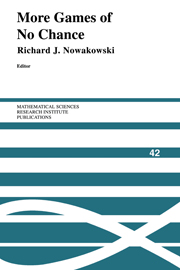Book contents
- Frontmatter
- Contents
- Preface
- The Big Picture
- Idempotents Among Partisan Games
- On the Lattice Structure of Finite Games
- More Infinite Games
- Alpha-Beta Pruning Under Partial Orders
- The Abstract Structure of the Group of Games
- The Old Classics
- Higher Nimbers in Pawn Endgames on Large Chessboards
- Restoring Fairness to Dukego
- Go Thermography: The 4/21/98 Jiang-Rui Endgame
- An Application of Mathematical Game Theory to Go Endgames: Some Width-Two-Entrance Rooms With and Without Kos
- Go Endgames Are PSPACE-Hard
- Global Threats in Combinatorial Games: A Computation Model with Applications to Chess Endgames
- The Game of Hex: The Hierarchical Approach
- Hypercube Tic-Tac-Toe
- Transfinite Chomp
- A Memory Efficient Retrograde Algorithm and Its Application to Chinese Chess Endgames
- The New Classics
- The 4G4G4G4G4 Problems and Solutions
- Experiments in Computer Amazons
- Exhaustive Search in Amazons
- Two-Player Games on Cellular Automata
- Who Wins Domineering on Rectangular Boards?
- Forcing Your Opponent to Stay in Control of a Loony Dot-and-Boxes Endgame
- 1 x n Konane: A Summary of Results
- 1-Dimensional Peg Solitaire, and Duotaire
- Phutball Endgames Are Hard
- One-Dimensional Phutball
- A Symmetric Strategy in Graph Avoidance Games
- A Simple FSM-Based Proof of the Additive Periodicity of the Sprague-Grundy Function of Wythoff's Game
- Puzzles and Life
- The Complexity of Clickomania
- Coin-Moving Puzzles
- Searching for Spaceships
- Surveys
- Unsolved Problems in Combinatorial Game Theory: Updated
- Combinatorial Games: Selected Bibliography With A Succinct Gourmet Introduction
1 x n Konane: A Summary of Results
Published online by Cambridge University Press: 29 May 2025
- Frontmatter
- Contents
- Preface
- The Big Picture
- Idempotents Among Partisan Games
- On the Lattice Structure of Finite Games
- More Infinite Games
- Alpha-Beta Pruning Under Partial Orders
- The Abstract Structure of the Group of Games
- The Old Classics
- Higher Nimbers in Pawn Endgames on Large Chessboards
- Restoring Fairness to Dukego
- Go Thermography: The 4/21/98 Jiang-Rui Endgame
- An Application of Mathematical Game Theory to Go Endgames: Some Width-Two-Entrance Rooms With and Without Kos
- Go Endgames Are PSPACE-Hard
- Global Threats in Combinatorial Games: A Computation Model with Applications to Chess Endgames
- The Game of Hex: The Hierarchical Approach
- Hypercube Tic-Tac-Toe
- Transfinite Chomp
- A Memory Efficient Retrograde Algorithm and Its Application to Chinese Chess Endgames
- The New Classics
- The 4G4G4G4G4 Problems and Solutions
- Experiments in Computer Amazons
- Exhaustive Search in Amazons
- Two-Player Games on Cellular Automata
- Who Wins Domineering on Rectangular Boards?
- Forcing Your Opponent to Stay in Control of a Loony Dot-and-Boxes Endgame
- 1 x n Konane: A Summary of Results
- 1-Dimensional Peg Solitaire, and Duotaire
- Phutball Endgames Are Hard
- One-Dimensional Phutball
- A Symmetric Strategy in Graph Avoidance Games
- A Simple FSM-Based Proof of the Additive Periodicity of the Sprague-Grundy Function of Wythoff's Game
- Puzzles and Life
- The Complexity of Clickomania
- Coin-Moving Puzzles
- Searching for Spaceships
- Surveys
- Unsolved Problems in Combinatorial Game Theory: Updated
- Combinatorial Games: Selected Bibliography With A Succinct Gourmet Introduction
Summary
ABSTRACT. We look at 1 x n Konane positions consisting of three solid patterns each separated by a single space and present forumulas for the values of certain positions.
Introduction
Combinatorial game theory [Berlekamp et al. 1982, Conway 1976] has discovered a fascinating array of mathematical structures that provide explicit winning strategies for many positions in a wide variety of games. The theory has been most successful on those games that tend to decompose into sums of smaller games. After assigning a game-theoretic mathematical value to each of the summands, these values are added to determine the value of the entire position. This approach has provided powerful new insights into a wide range of popular games, including Go [Berlekamp and Wolfe 1994], Dots-and-Boxes [Berlekamp 2000a], and even certain endgames in Chess [Elkies 1996].
Some positions on two-dimensional board games breakup into one-dimensional components, and the values of these components often have their own interesting structures. Examples include Blockbusting [Berlekamp 1988], Toads and Frogs [Erickson 1996] and Amazons [Berlekamp 2000b]. The same is true for Konane as suggested by previous analyses of one-dimensional positions [Ernst 1995 and Scott 1999].
Konane is an ancient Hawaiian game similar to checkers. It is played on an 18x18 board with black and white stones placed in an alternating fashion so that no two stones of the same color are in adjacent squares. Two adjacent pieces adjacent to the center of the board are removed to begin the game. A player moves by taking one of his stones and jumping, in the horizontal or vertical direction, over an adjacent opposing stone into an empty square. The jumped stone is removed. A player can make multiple jumps on his turn but cannot change direction mid turn. The first player who cannot make a move loses.
Our goal was to find values for all possible 1 x n Konane positions that consist of three solid patterns each separated by a single space, which we call an “almost solid pattern with two spaces”. We assumed that the positions were far away from the edges of the board so that there was no interference.
Information
- Type
- Chapter
- Information
- More Games of No Chance , pp. 331 - 340Publisher: Cambridge University PressPrint publication year: 2002
